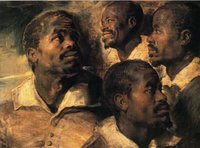Pressured by Dutch abolitionists and slave resistance, slavery was abolished in the overseas Dutch colonies Surinam and the Net
 herlands Antilles on 1st July 1863. In Surinam, this 1st July is known as Keti Koti (chains cut or broken chains).
herlands Antilles on 1st July 1863. In Surinam, this 1st July is known as Keti Koti (chains cut or broken chains).Here in Holland, Amsterdam in particular, many festivities will take place to commemorate the event. The Kwakoe Festival in the Bijlmerpark, Amsterdam Zuidoost being one of them: www.kwakoe.nl. For six consecutive weekends, the organization offers an extensive programme containing (live) music, films, sports, food, dance, information and meetings. The Festival has a different theme every year which is noticeable in the music, performances, art and literature.

BTW, Kwakoe was the name of a runaway but recaptured slave. His story came to represent the urge for freedom.
Wish to know more about this black chapter of Dutch history? Go to: http://www.suriname.nu or http://www.schooltv.nl/slavernij. You might also want to read up on it. If so, check out THE book on slavery in Surinam: Wij Slaven van Suriname by Anton de Kom.
The painting on the right-hand side is from the famous Flemish painter Rubens called "Negerkoppen". The original can be found in the Royal Museums of Fine Arts of Belgium, Brussels.
